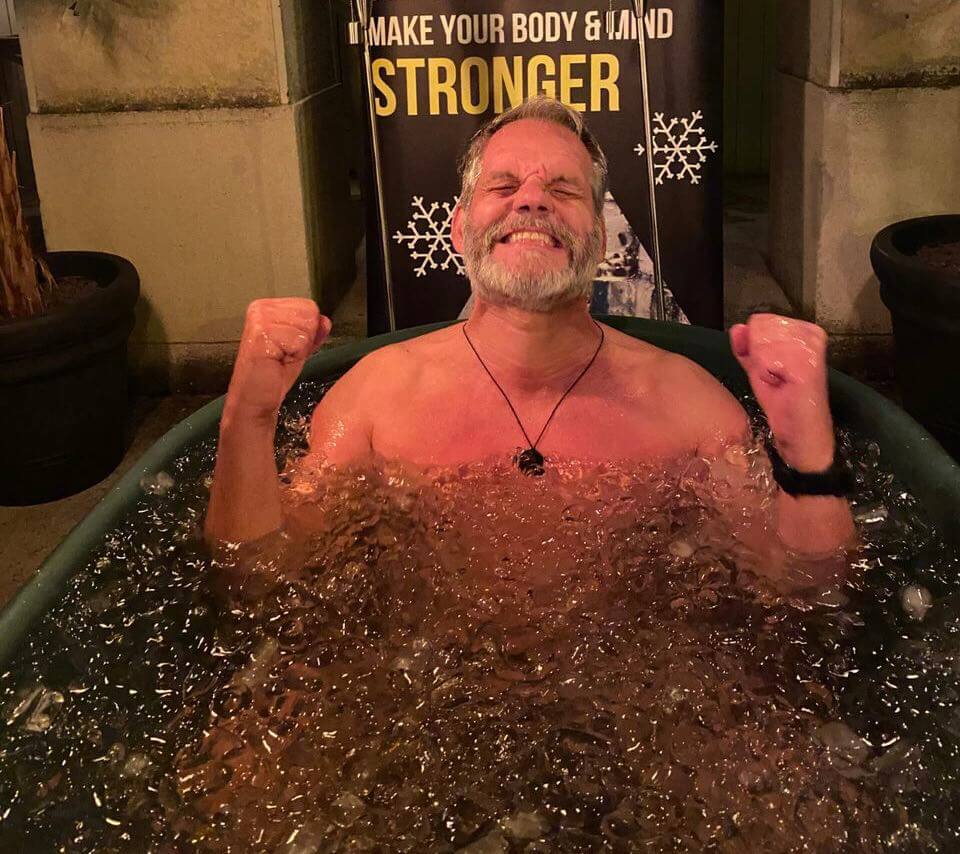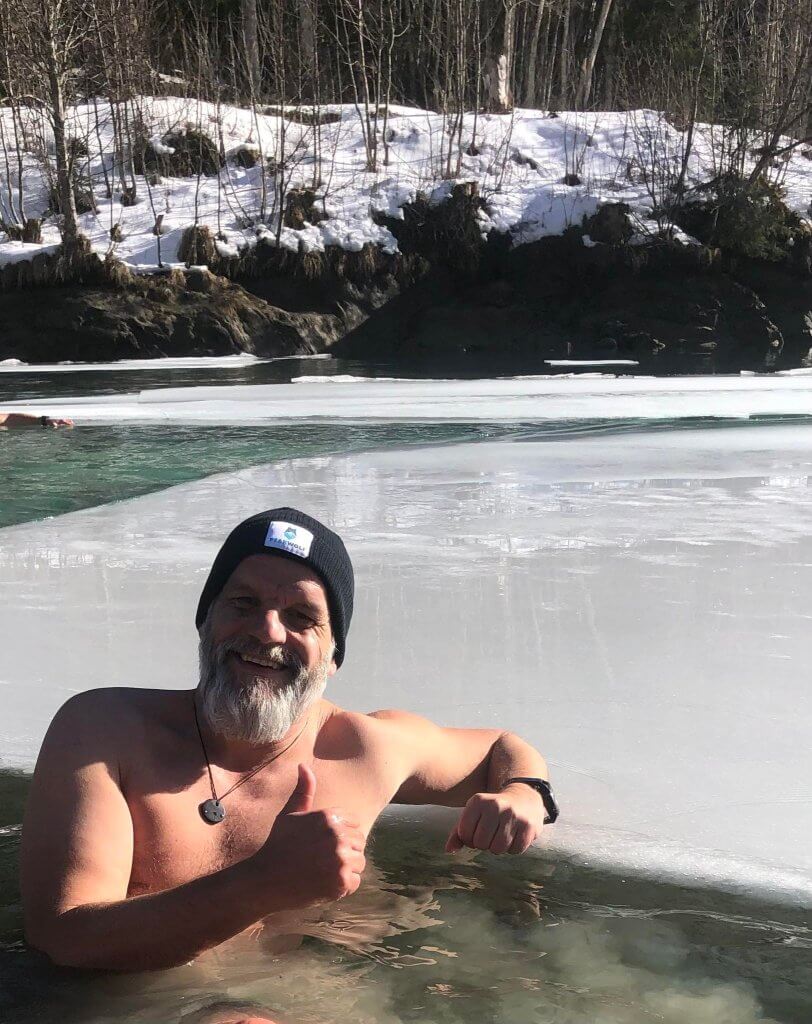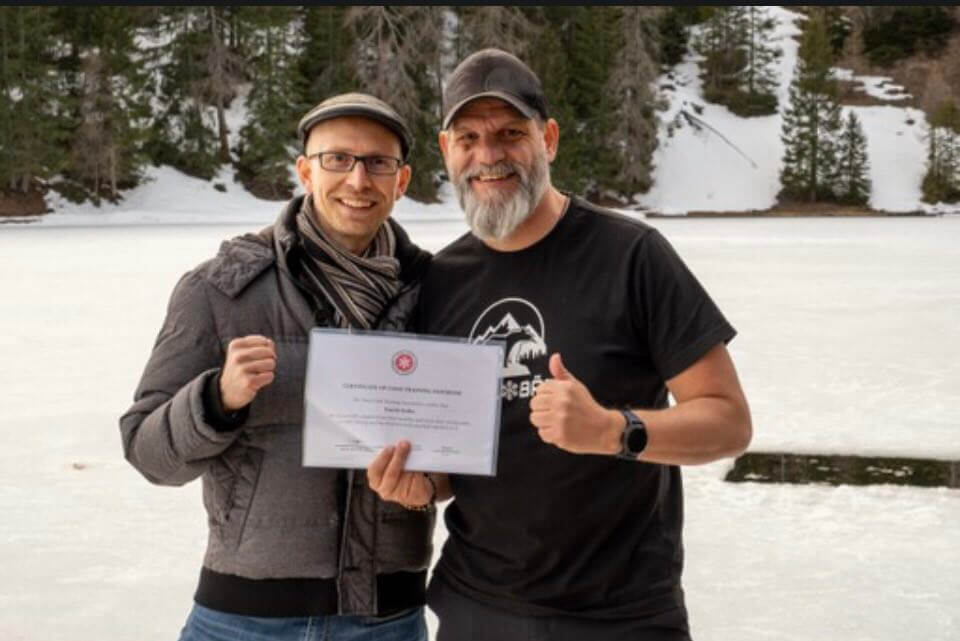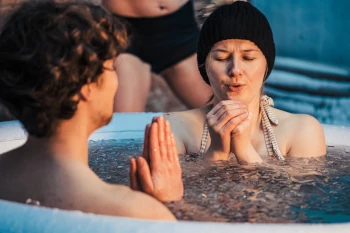
Table of contents
Constantin ( Cold Plunge .de): Today we talk to Patrick Boillat about topics such as Cold Plunge , winter swimming, cold exposure, organic paint and mental resilience. Patrick, you call yourself cool, come from Switzerland and have recently also been a certified trainer at the Swiss Cold Training Association. Congratulations!
Patrick Boillat: Thank you, I am a pleasure to be here. My name is Patrick Boillat, also known as a cool bear. I am 51 years old and have been dealing with Cold Plunge . I was originally a banker, but my experiences with the Cold Plunge motivated me to concentrate more on this topic. I live in Switzerland and offer my courses and workshops in the area.
Constantin: That sounds very exciting. How did you get from banking to Cold Plunge , isn't that a typical career path?
"Burnout made me start with breathing techniques and Cold Plunge ."
Patrick: I used to work in sales and had to deliver higher and higher numbers. At some point my body said "up to here and not on", and I suffered a burnout. I spent some time in a clinic and learned how I could connect to my body again and find myself. When I was released from the clinic, I really wanted to continue and looked for opportunities to train my body and mind. I came across Wim Hof's breathing techniques and took part in some workshops. When immersing it in an ice cream tray at one of these workshops, I felt a feeling of calm and clarity for the first time that I had never experienced before. That was the moment when I decided to spend more time with Cold Plunge .
Constantin: That sounds impressive. How has your life changed since then? What positive results have you been able to determine through the Cold Plunge ?

"I have a daily Cold Plunge routine."
Patrick: It was important to me Cold Plunge into my daily routine. I go into the water every day and in the morning I have my routines regarding breathing. I do the Wim Hof Breathing two to three times a week, which contributes to regeneration of stress in everyday life. I noticed that I can say in difficult situations, be it professionally or privately: "I was at zero, maybe at two degrees in the cold water, what else prevents me from?" I feel more vital and fitter and can better prepare for the day.
Constantin: That's right, there are many positive aspects that I also noticed for myself. Of course, it doesn't have to be a burnout, but there are many situations and events in life where you have to be very focused. As you said, the cold helps immensely to restore the focus. I always notice that after an ice pool I have clarity and focus all day long. And this effect continues.
"After the Cold Plunge the effect lasts 2 to 3 days."
Patrick: That's exactly how it is. It is said that dopamine and adrenaline last for almost two to three days. It is very different if you consume chocolate or coffee, because the dopamine and adrenaline level only rises in the short term and then goes back quickly. Therefore, you don't have to go to the ice water every day to feel the benefit. But for me it is almost a must because it is so good.
Constantin: Of course, going into the water every day is extreme. But the more you do it, the more often you want to repeat it.
Patrick: It was the same with me. I started to take part in workshops once a month, and then it got more and more. Ultimately, I decided Cold Plunge to my daily routine so that I don't forget it and because it is good for me. I also have a group in Thun on Tuesday evening, we are usually between six and twelve people. On Sunday I was on the moss with another group. So I already have two fixed appointments, and that also helped me to certify the cold expert because it was concrete training for me to pass the training.
Constantin : Tell us something about your role as a trainer. What kind of coaching license did you get? How difficult it was and what methods did you learn?
Patrick: I am a certified cold expert from Swiss Cold Association with a location in Zurich. I also attended further training at Rolf Duda (Peakwolf). The topic of Cold Plunge is booming and there are many people who want to try it out. However, false methods and approaches often occur, which can be dangerous. It was very important to me to train well in order to be able to lead workshops.
The training of Swiss Cold Association was divided into different modules. We practiced ice swimming at 5 degrees on a distance of 100 meters and then looked at how the body reacts to it. It was very important for me to understand what happens in my body when I go into the ice water. What exactly happens to the cells and tissue? What do I have to pay attention to when I feel the so -called "Brain Fog" because I stayed in the cold water for too long? And of course the emergency helper course was also important in order to be able to react correctly in an emergency - the circumstances are not, for example, to compare with a car accident.
The training also included a cold experiment, in which we only hiked in swimming trunks for an hour at -8 degrees. And of course we practiced Cold Plunge , at 3 degrees water temperature and -8 degrees outside temperature. Furthermore, we looked at all the different breathing techniques, i.e. the WIM Hof-Buck, Buteyko breathing, soma breathing and transformative breathing. I also learned how to lead a workshop and advertise his courses. Overall, this was an extensive training with theory and practice, which now enables me to professionally lead workshops.
"With Cold Plunge you should go into the water relatively quickly, otherwise the body notices that it is too cold for him."
Constantin : How does the walk into ice water look optimally?
Patrick: With Cold Plunge you usually get into the water relatively quickly and then dive to protect the important organs such as the heart, the lungs and the torso. If you slowly go in or only make your hand or foot in the water, the body quickly notices that it gets cold and protects the rest of the body from cold. You may then feel severe pain in your feet or hands. It is therefore advisable to go into the water quickly and then immerse yourself directly so that the body has no time to notice the cold.
Constantin : I agree with you that you should go into the water quickly, but not so quickly that you overwhelm the body. In summer I might jump into the water, but I would slowly run into an ice -cold lake, pause a few seconds and then dive. If you think about it for too long, you probably won't do it.
Patrick : An important point are the temperature differences. If you go into the water at an outside temperature of 25 degrees at 3 degrees or at an outside temperature of 5 degrees into the water at 1 to 5 degrees, the body reacts differently to the cold. You should always keep an eye on it.
Constantin: Do you have a tip for beginners how long you should stay in the water at different water temperatures? Certainly this also depends on the individual feeling, but is there a minimum time that should not be fallen below?

"2 minutes of Cold Plunge are sufficient for the body."
Patrick : It is important to listen to the body. If you notice after a minute and a half that the body does not feel good, you should go out of the water for safety's sake. For beginners, I recommend a minimum time of two minutes at water temperatures of 3 to 5 degrees . During this time you can feel the advantages that the Cold Plunge brings, such as the formation of brown fat and faster upsight. Cold Plunge regularly , you cannot achieve this effect. The challenges that you often see on Facebook or YouTube, which are about who can stand it in the ice water for the longest, are not necessarily optimal. Two minutes are sufficient for the body, and it is more important to listen to the body and experience Cold Plunge If you stay in the water for too long, your hands and feet have difficulty warming up. It is important to always do the best for your own body so that the Cold Plunge remains a pleasant experience.
Constantin: I agree with you that it should be a positive experience and that you shouldn't overwhelm the body. What is your opinion on breathing techniques in Cold Plunge ?
Patrick: Cold Plunge is very often associated with the WIM Hof breathing, and unfortunately many mistakes are made with this breathing technique. The problem is that the WIM Hof-Battlung is a stress breathing that leads to hyperventilation. If you trigger the body in front of the Cold Plunge and push the stress up, it is an enormous challenge and therefore not optimal. This means that you should take the WIM court breathing, if at all, 1 to 2 hours in front of the Cold Plunge . I do the Wim Hof-Battung 2 to 3 times a week. You have to compare this breathing a little with a fitness center, because that is also strength training, namely for the organs and the vagus nerve, the biggest nerve. If you do that too much, you can also get sore muscles of it, as with strength training, and then you are too stressed.
What I do every day is Buteyko breathing-a breathing technique that is very well down. You make sure that you increase resilience through slower breathing. You can always do the butyco breathing, for example on the way to the office or bus. As I go, I just stop my breath and count how many steps I can stop.
Transformative breathing is the most intense breathing that I have met. This goes between 1 to 1.5 hours and you dive very deep to solve traumas. If you succeed in solving something in yourself, it happens on a emotional level that you don't get with any other breathing technique!
Constantin: In Switzerland you usually have enough cold water, even in summer there are really fresh mountain streams. So you have everything you need for the Cold Plunge .
Patrick: Exactly, we take that into account. Later in spring, when it gets warmer again, go to the mountains and go on a hike to the mountain lakes. It is a completely different feeling than sitting in a tub. You enjoy nature very differently and find peace there.
Constantin: Who are your participants and what motivation do you usually bring with you?
"It is important to leave the comfort zone."
Patrick: The groups are quite mixed. Many participants say that they want to break out of their comfort zone and want to try something new. They were often made aware of the Cold Plunge and have never bathed in the ice water. Others come to me with a specific problem, such as a participant with a broken arm that still has pain and inflammation. The participants have heard that Cold Plunge is good for inflammation and want to try it out. It is astonishing that some have already felt an improvement after the first ice pool, since not only a certain area, but the entire body was cooled. Another goal of mine is to support people who are about to be burnout and pick them up before it is too late. I would like to support these people with work-life balance and Cold Plunge to get them out of the hamster wheel and prevent burnout. That is the goal for my next workshops.
Constantin: Prevention is very important, especially in our stressful society. Did you get feedback from participants who maintain the Cold Plunge as a regular routine?
Patrick: Yes, the feedback is always positive. The participants have a good feeling and are motivated to continue. Unfortunately, however, there is also a risk that some participants will not continue the Cold Plunge after the workshop. To avoid this, I founded a WhatsApp group in which the participants can stay in contact after my workshop. We plan joint events or challenges and thus hold the group together. The goal is to bring the participants further and build a routine to avoid stress and burnout.
Constantin : That sounds great. It is nice to hear that the group remains in contact after the workshop and supports each other. Thank you very much, Patrick, for the interesting conversation and that you shared your experiences with us. I would be happy if we will soon make it together in the ice hole!







